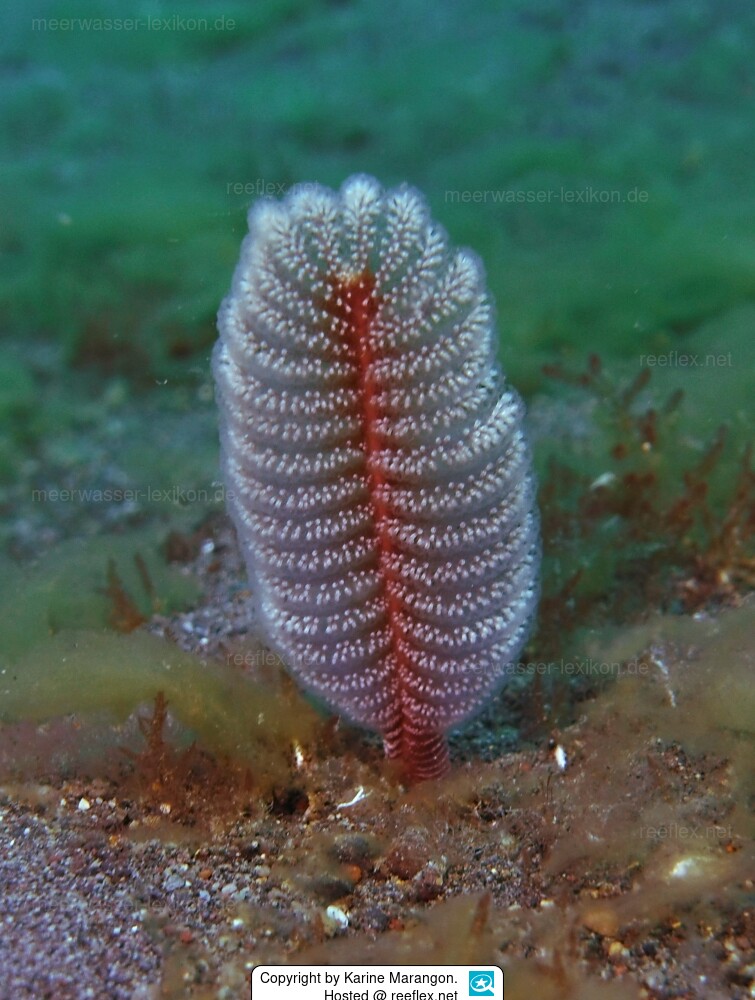Info
Virgularia gustaviana (Herklots, 1863)
Sea feathers belong to the eight-rayed corals, even if at first glance there are only a few similar characteristics.
However, one difference to their close relatives, the leather corals, becomes particularly clear: While leather corals sit firmly on the substrate, the sea pen is not fused to the substrate, but buries its foot in the sandy or muddy bottom.
It has an elastic stem and stands loosely. Sea feathers are filter feeders that feed on plankton!
To maintain sea feathers in your aquarium, you should provide a higher substrate.
In the literature we found hints ranging from 15 to 20 cm. Most sea feathers are nocturnal. Many species glow in the dark - usually after being irritated or touched.
Synonymised names:
Halisceptrum gustavianum Herklots, 1863 · unaccepted (original combination)
Halisceptrum gustavianum var. magnifolia Kölliker, 1870 · unaccepted (synonym)
Halisceptrum gustavianum var. parvifolia Kölliker, 1870 · unaccepted (synonym)
Halisceptrum magnifolium Kölliker, 1870 · unaccepted (synonym)
Halisceptrum parvifolium Kölliker, 1870 · unaccepted (synonym)
Halisceptrum periyense Thomson & Henderson, 1905 · unaccepted (synonym)
Sceptonidium mosambicanum Richiardi, 1869 · unaccepted (synonym)
Direct children (1):
Subspecies Virgularia gustaviana parvifolia Kölliker (uncertain > unassessed)
Sea feathers belong to the eight-rayed corals, even if at first glance there are only a few similar characteristics.
However, one difference to their close relatives, the leather corals, becomes particularly clear: While leather corals sit firmly on the substrate, the sea pen is not fused to the substrate, but buries its foot in the sandy or muddy bottom.
It has an elastic stem and stands loosely. Sea feathers are filter feeders that feed on plankton!
To maintain sea feathers in your aquarium, you should provide a higher substrate.
In the literature we found hints ranging from 15 to 20 cm. Most sea feathers are nocturnal. Many species glow in the dark - usually after being irritated or touched.
Synonymised names:
Halisceptrum gustavianum Herklots, 1863 · unaccepted (original combination)
Halisceptrum gustavianum var. magnifolia Kölliker, 1870 · unaccepted (synonym)
Halisceptrum gustavianum var. parvifolia Kölliker, 1870 · unaccepted (synonym)
Halisceptrum magnifolium Kölliker, 1870 · unaccepted (synonym)
Halisceptrum parvifolium Kölliker, 1870 · unaccepted (synonym)
Halisceptrum periyense Thomson & Henderson, 1905 · unaccepted (synonym)
Sceptonidium mosambicanum Richiardi, 1869 · unaccepted (synonym)
Direct children (1):
Subspecies Virgularia gustaviana parvifolia Kölliker (uncertain > unassessed)







 Kary Mar
Kary Mar






